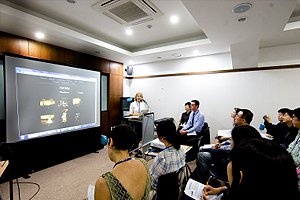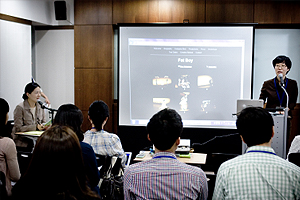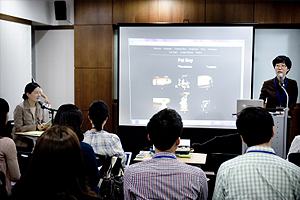As a function of the Performing Arts Market in Seoul 2011, the members of the National Performance Network (NPN) of the United States introduced contemporary US performing artists and troupes at the National Theater of Korea on October 11, 2011. NPN comprises 61 artist-centered presenting organizations and the NPN Partners, representing every region of the country, and celebrates its 26th anniversary this year (founded in 1985). It aims to create meaningful partnerships among performing arts organizations and centers, to share the information on the contemporary artists, and provide financial support to the artists in the United States. From about a decade ago, it started expanding its exchange beyond the borders of North America with the title of Performing Americas. Now, it cooperates with Latin American artists and their groups, led by La Red, the association consisting of producers in the region. Moreover, it has been building cooperative relations with the Korea Arts Management Service as part of its KAMS Connection partner for 2 years. Now, the program mainly focuses on mutual exchange of information, and plans to pursue direct exchange among the artists of both sides.
What NPN focuses in global exchange is how to facilitate information flow and to build efficient information networks
What NPN focuses in global exchange is how to promote mutual exchange of artists and to build efficient information networks. Showing a work in the partner country is for mutual exchange of artists. Meanwhile, the latter is intended as a long-term vehicle for securing constant exchange, even when a counterpart is unable to put its piece on stage in the other country.
At its annual convention, each partner organization makes presentations on how performing arts are conducted across the United States. This year, NPN made it at the PAMS. This year’s presentation was a revamped representation of last year’s, focused on contemporary performing arts. Chosen for the presentation were four organizations representing the Eastern, the Western and the Central United States, along with the State of Alaska, to represent the entire country. The presentation also introduced a variety of experimental works touching on music, theatre, dance and other types of performing arts programs. Especially, centers dealing with multiple cultural genres participated as well, which simultaneously pursue art and performing arts programs.
Topic for Local Community
Producer of Out North in Anchorage, Scott Schofield introduced the programs concerning his local community with focus on the individuals copying with collective interests and environment. The programs seemed to arouse the demand for their meanings, interest and topics, in consideration of ethnic, race, environmental and political characteristics of the State. Schofield stressed that the company’s residency program contributes to creation of works enabling exchange with foreign local communities.
Teo Castellanos D-projects are the vehicle to deliver strong social messages, employing hip-hop and break dance. A recent brainchild of the program, Fat Boy is about poverty, famine and trash, and accommodates the pop culture of the 1980s, meditation, and social suggestions. Trained in contemporary ballet and jazz by trade for more than 30 years, artist and educator Leslie K. Ward showed a great interest in educational and local community programs. The 1000 Cranes for Alaska campaign, founded by her, is spreading across America, which is to prevent suicide. Lately inspired by her own experience with gypsy and carnival cultures, life in the Southern United States, and her Japanese heritage, she has released dance piece Orphan expressed in strong vocal and colloquialism. A dance troupe, the Pat Graney Company worked out a 500-m2 intallation piece House of Mind, in cooperation with local folks. To represent the mental image of home, audiences are allowed not only to watch, but also to touch and feel things reminiscent of their memories about home, along with the performance of dancers within the structure. Based on the local culture arising out of his memory about his grandfather, who had been the last shaman of the Yupik people, storyteller Jack Dalton introduced works highlighting the importance of storytelling in preserving culture.
Contemporary Arts Delivered in Multimedia and Multi-genre Arts
George Lugg introduced multimedia works, who is the associate director of REDCAT that wishes to mark itself as the contemporary arts center representing the Western United States. Big Art Group expands the boundaries of theatre and its tools of expression by simultaneously projecting what actors do on stage on multiple screens. In addition, The People shows interviews with ordinary people about their concepts on democracy, war, terrorism justice, along with ancient Greek tragedian Aeschylus’s The Oresteia. It appropriately depicts how to communicate within a local community and how democracy was born. This work had toured Austria, Germany, San Francisco and New York, reproduced in distinct versions. Multimedia artist, Miwa Mateyek is the founder of Cloud Eye Control that resorts to media as performance tool. She created a work mingling animation with actual performance and installation. Myth and Infrastructure is a performance in which her silhouette intervenes over the screen where an animation is projected. The animation deals with primitive world and congested urban space. Paralleling fantasy with non-fantasy in combination of human body and virtual space, it expresses in metaphor collapse of the former.
In charge of performing arts programs at the Museum of Contemporary Arts Chicago, Yolanda Cesta Cursach paid attention to and introduced the artists that have worked on collaborative works in the city where more than 300 performing groups exist. Founder of Lucky Plush Productions, Julia Rhoads presented a dance performance The Better Half that reinterprets Gaslight of 1944, which deals with a wife who is led by her husband to the belief that she is a mental patient. The Better Half illustrates the instable human relations of today. Tsukasa Taiko At JASC is a tour group consisting of African-Americans and Asian-Americans in the United States. Incorporating the Japanese drum “taiko” and improvised performance by renowned jazz musicians, the group draws attention at diverse jazz festivals in the United States.
Representing Legion Arts in Minneapolis, Minnesota, John Herbert introduced pieces associated with music. Interested in grafting of contemporary music and mass media, composer Mikel Rouse has created a talk show-like opera in which he plays host and audiences participate as guests. His latest work Gravity Radio was born out of his inspiration about theoretically existing, but undetectable waves. This work is played in a mixture of the voice and the guitar sound carried by his own band, the string quartet recruited in the local community where it is played, short wave radio frequency, and live AP radio news broadcast.
Moreover, Hijack introduced Smithsoniansmith. The entity pursues low-tech esthetics through employment of a stage where ordinary things are intentionally stacked. Morgan Thorson from Minneapolis parallels physical moves with the language repeating at a place like an auction. He draws attention to his collaboration with the renowned Minnesota indie band Low.
Leads Killing Prejudices
It is impossible to understand the contemporary performing arts in the United States with brief images and summaries of the works presented during the 90-minute session. The presentation demonstrated how distinct genres and cultures try to accommodate each other and how the efforts are expressed. But it was not sufficient to give an insight into artists and hidden messages. But it sufficed to put out the prejudice that the United States lags behind Europe in terms of performing arts. The puzzle pieces thrown by NPN partner organizations helped put in perspective the broader picture of American contemporary performing arts. These leads hopefully contribute to exchange of the artists across the Pacific and to stimulation of mutual contribution.
Links| the National Performance Network(NPN)
GO| La Red
GO| Anchorage Out North
GO
 EXTENDED RUN: B!D!F!W! Penny Arcade
EXTENDED RUN: B!D!F!W! Penny Arcade EXTENDED RUN: B!D!F!W! Penny Arcade
EXTENDED RUN: B!D!F!W! Penny Arcade



